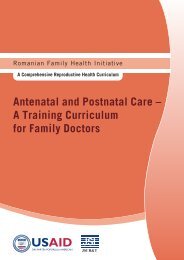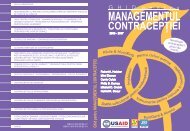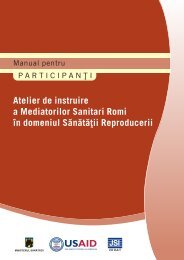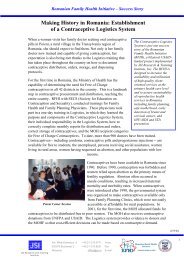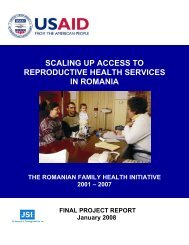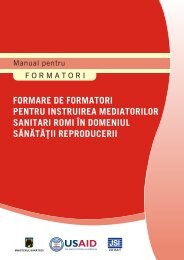Training of Roma Health Mediators in Reproductive Health
Training of Roma Health Mediators in Reproductive Health
Training of Roma Health Mediators in Reproductive Health
Create successful ePaper yourself
Turn your PDF publications into a flip-book with our unique Google optimized e-Paper software.
• The baby suckles as <strong>of</strong>ten and for as long as he wants.<br />
• The environment supports breastfeed<strong>in</strong>g.<br />
IV.<br />
COMMON PROBLEMS DURING BREASTFEEDING (15 m<strong>in</strong>utes)<br />
Briefly present the most frequent problems (common breast conditions which sometimes<br />
cause difficulties) <strong>in</strong> breastfeed<strong>in</strong>g:<br />
• Sore or cracked nipples<br />
• Breast engorgement<br />
• Blocked ducts (tubes)<br />
• Pa<strong>in</strong>ful breasts<br />
• Breast <strong>in</strong>fections (mastitis and abscess)<br />
Emphasize that diagnosis and management <strong>of</strong> these breast conditions are important<br />
both to relieve the mother, and to enable breastfeed<strong>in</strong>g to cont<strong>in</strong>ue.<br />
Distribute the participant document Common Problems dur<strong>in</strong>g Breastfeed<strong>in</strong>g, and ask<br />
volunteers to read it. Distribute participant document Care <strong>of</strong> the Breasts dur<strong>in</strong>g<br />
Breastfeed<strong>in</strong>g and ask volunteers to read it.<br />
Allow participants to ask questions and try to answer them, us<strong>in</strong>g the tra<strong>in</strong>er document<br />
Answers to Frequently Asked Breastfeed<strong>in</strong>g Questions, as a basis.<br />
V. MEDIATOR’S ROLE IN PROMOTING BREASTFEEDING (20<br />
m<strong>in</strong>utes)<br />
Divide participants <strong>in</strong>to small groups. Give them slips <strong>of</strong> paper with a myth written on<br />
each slip (see tra<strong>in</strong>er document Myths about Breastfeed<strong>in</strong>g). Ask them to discuss each<br />
myth and fact. One person from each group will present the group’s response to their<br />
myth. Correct and/or complete their responses as necessary<br />
Generate a discussion about the mediators’ roles <strong>in</strong> promot<strong>in</strong>g exclusive breastfeed<strong>in</strong>g<br />
and support<strong>in</strong>g mothers with breastfeed<strong>in</strong>g. Ensure that the mediator’s role <strong>in</strong>cludes the<br />
follow<strong>in</strong>g:<br />
• Antenatal preparation for breastfeed<strong>in</strong>g<br />
With mothers <strong>in</strong> groups:<br />
o Expla<strong>in</strong> benefits <strong>of</strong> breastfeed<strong>in</strong>g<br />
o Give simple relevant <strong>in</strong>formation on how to breastfeed<br />
o Expla<strong>in</strong> what happens after delivery<br />
o Discuss mothers' questions<br />
With each mother <strong>in</strong>dividually<br />
o Ask if she has any questions or worries<br />
o Build her confidence, and expla<strong>in</strong> that you will help her<br />
• Education <strong>of</strong> young mothers<br />
149<br />
RFHI/JSI <strong>Roma</strong>nia <strong>Tra<strong>in</strong><strong>in</strong>g</strong> <strong>of</strong> RHMs <strong>in</strong> <strong>Reproductive</strong> <strong>Health</strong> Session 9: Breastfeed<strong>in</strong>g



